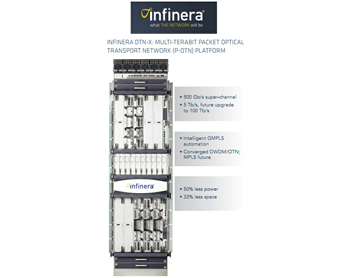Verizon continues to expand the number of 100G routes in its ultra-long-haul network in the U.S. and Europe, adding 100G technology to more than 4,800 miles of its global IP network during the first half of 2013.
The 100G expansion includes almost 4,500 miles on the Verizon U.S. network, bringing to approximately 21,400 the total number of 100G miles currently deployed on the network. Among the new 100G routes are Seattle to Salt Lake City, Indianapolis to St. Louis, St. Louis to Memphis, Charlotte to Nashville and Cleveland to Detroit.
The company has a goal of deploying an additional 8,700 100G miles in the U.S. by the end of the year.
In Europe, Verizon deployed 100G on an additional 350 miles between Brussels and Frankfurt, bringing to 5,100 the total number of 100G miles in Europe. The company plans to deploy an additional 1,400 miles by the end of this year.
Verizon is using Juniper PTX packet transport routers and the Ciena 6500 Packet-Optical Platform.
"Not only does Verizon have one of the largest global networks, we have one of the most robust and sophisticated networks with 100G technology deployed on multiple routes in the U.S. and Europe,” said Kyle Malady, senior vice president of global network operations and engineering. “As long as our bandwidth demand grows, we’ll continue deploying high bit-rate technology that underlies the superior experience that our business and consumer customers expect."
http://newscenter.verizon.com/corporate/news-articles/2013/09-09-verizon-expands-100g-technology/#sthash.Bgf2gtXX.dpuf
The trial, which ran for more than a month on the live network, used the same hardware that currently supports Verizon's 100G ultra-long-haul traffic, along with pre-production software to configure a Ciena Wavelogic3 coherent optical processor. The trial used 16QAM (quadrature amplitude modulation) on a single wavelength with the typical 50GHz channel spacing to increase the amount of traffic carried.
Verizon said the test proves the ability to double spectral efficiency while reducing the cost per bit when compared with 100G technology.
The 100G expansion includes almost 4,500 miles on the Verizon U.S. network, bringing to approximately 21,400 the total number of 100G miles currently deployed on the network. Among the new 100G routes are Seattle to Salt Lake City, Indianapolis to St. Louis, St. Louis to Memphis, Charlotte to Nashville and Cleveland to Detroit.
The company has a goal of deploying an additional 8,700 100G miles in the U.S. by the end of the year.
In Europe, Verizon deployed 100G on an additional 350 miles between Brussels and Frankfurt, bringing to 5,100 the total number of 100G miles in Europe. The company plans to deploy an additional 1,400 miles by the end of this year.
Verizon is using Juniper PTX packet transport routers and the Ciena 6500 Packet-Optical Platform.
"Not only does Verizon have one of the largest global networks, we have one of the most robust and sophisticated networks with 100G technology deployed on multiple routes in the U.S. and Europe,” said Kyle Malady, senior vice president of global network operations and engineering. “As long as our bandwidth demand grows, we’ll continue deploying high bit-rate technology that underlies the superior experience that our business and consumer customers expect."
http://newscenter.verizon.com/corporate/news-articles/2013/09-09-verizon-expands-100g-technology/#sthash.Bgf2gtXX.dpuf
Last month, Verizon completed a field trial of 200G technology on a network route between New York and Boston.
The trial, which ran for more than a month on the live network, used the same hardware that currently supports Verizon's 100G ultra-long-haul traffic, along with pre-production software to configure a Ciena Wavelogic3 coherent optical processor. The trial used 16QAM (quadrature amplitude modulation) on a single wavelength with the typical 50GHz channel spacing to increase the amount of traffic carried.
Verizon said the test proves the ability to double spectral efficiency while reducing the cost per bit when compared with 100G technology.

























